Comprehensive Case Study: Amazon Web Services Cloud Computing Analysis
VerifiedAdded on 2023/01/10
|8
|1766
|91
Case Study
AI Summary
This case study examines Amazon Web Services (AWS) as a prominent cloud computing service. It delves into AWS's history, advantages, such as increased efficiency, reliability, and economies of scale, and disadvantages, including security concerns. The report also explores alternative e-commerce models and mobile cloud services, highlighting their significance. Furthermore, it evaluates the future of cloud computing, emphasizing the need for advancements in areas like identity management and security. The study concludes by underscoring the benefits of AWS and the importance for organizations to exploit cloud computing to their advantage.

Cloud Computing
Student’s name
Institution Affiliation(s)
Student’s name
Institution Affiliation(s)
Paraphrase This Document
Need a fresh take? Get an instant paraphrase of this document with our AI Paraphraser
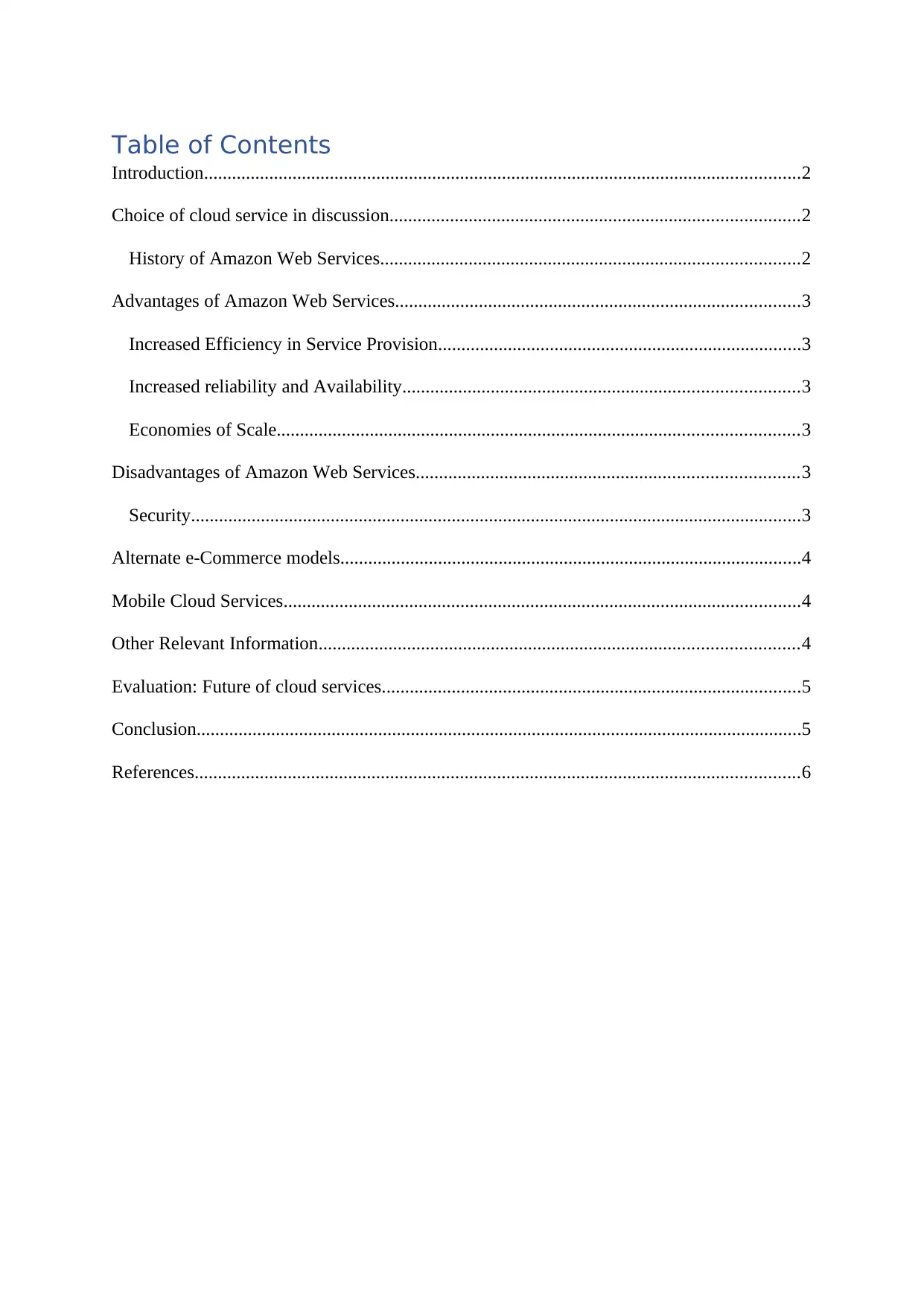
Table of Contents
Introduction................................................................................................................................2
Choice of cloud service in discussion........................................................................................2
History of Amazon Web Services..........................................................................................2
Advantages of Amazon Web Services.......................................................................................3
Increased Efficiency in Service Provision..............................................................................3
Increased reliability and Availability.....................................................................................3
Economies of Scale................................................................................................................3
Disadvantages of Amazon Web Services..................................................................................3
Security...................................................................................................................................3
Alternate e-Commerce models...................................................................................................4
Mobile Cloud Services...............................................................................................................4
Other Relevant Information.......................................................................................................4
Evaluation: Future of cloud services..........................................................................................5
Conclusion..................................................................................................................................5
References..................................................................................................................................6
Introduction................................................................................................................................2
Choice of cloud service in discussion........................................................................................2
History of Amazon Web Services..........................................................................................2
Advantages of Amazon Web Services.......................................................................................3
Increased Efficiency in Service Provision..............................................................................3
Increased reliability and Availability.....................................................................................3
Economies of Scale................................................................................................................3
Disadvantages of Amazon Web Services..................................................................................3
Security...................................................................................................................................3
Alternate e-Commerce models...................................................................................................4
Mobile Cloud Services...............................................................................................................4
Other Relevant Information.......................................................................................................4
Evaluation: Future of cloud services..........................................................................................5
Conclusion..................................................................................................................................5
References..................................................................................................................................6
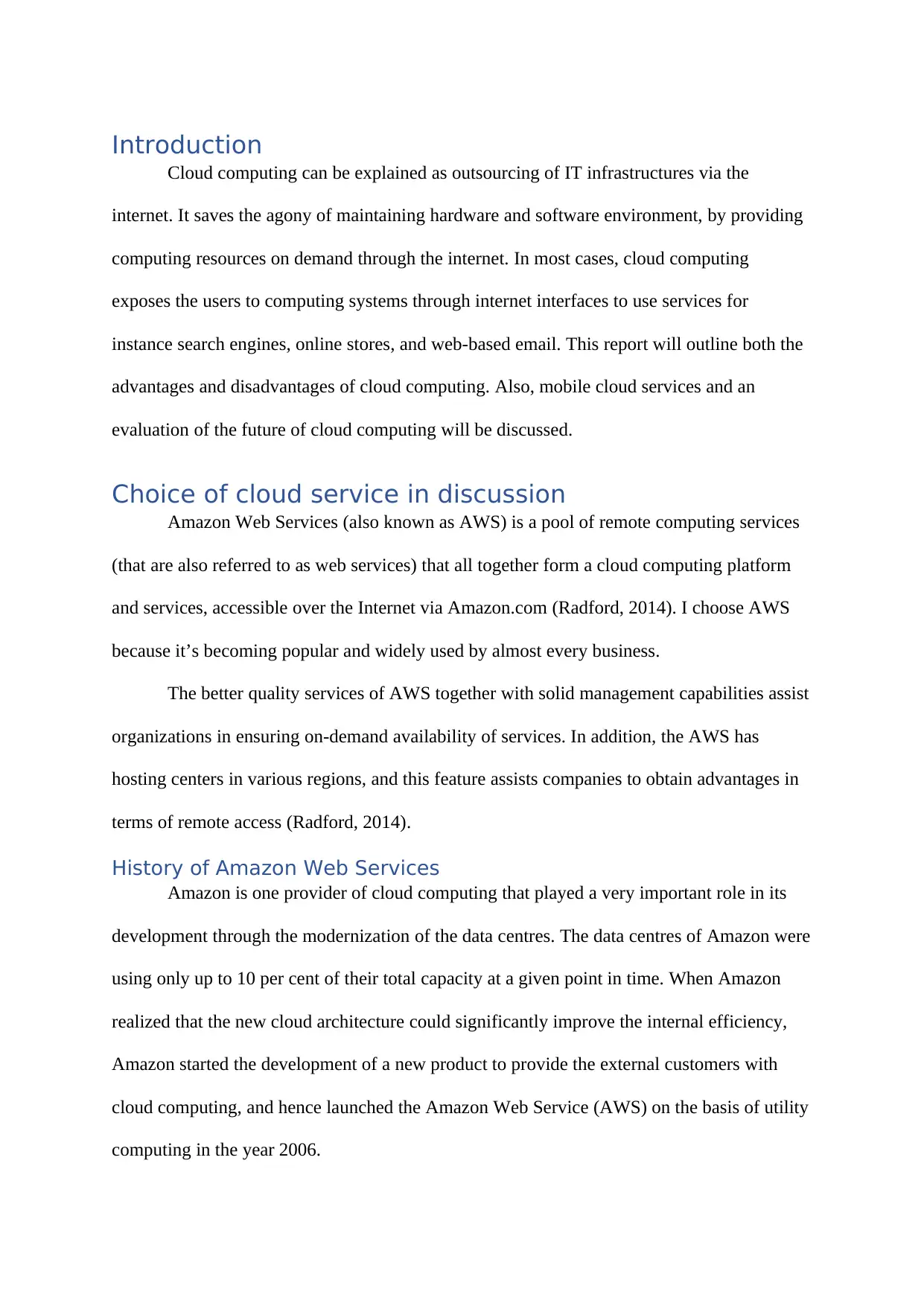
Introduction
Cloud computing can be explained as outsourcing of IT infrastructures via the
internet. It saves the agony of maintaining hardware and software environment, by providing
computing resources on demand through the internet. In most cases, cloud computing
exposes the users to computing systems through internet interfaces to use services for
instance search engines, online stores, and web-based email. This report will outline both the
advantages and disadvantages of cloud computing. Also, mobile cloud services and an
evaluation of the future of cloud computing will be discussed.
Choice of cloud service in discussion
Amazon Web Services (also known as AWS) is a pool of remote computing services
(that are also referred to as web services) that all together form a cloud computing platform
and services, accessible over the Internet via Amazon.com (Radford, 2014). I choose AWS
because it’s becoming popular and widely used by almost every business.
The better quality services of AWS together with solid management capabilities assist
organizations in ensuring on-demand availability of services. In addition, the AWS has
hosting centers in various regions, and this feature assists companies to obtain advantages in
terms of remote access (Radford, 2014).
History of Amazon Web Services
Amazon is one provider of cloud computing that played a very important role in its
development through the modernization of the data centres. The data centres of Amazon were
using only up to 10 per cent of their total capacity at a given point in time. When Amazon
realized that the new cloud architecture could significantly improve the internal efficiency,
Amazon started the development of a new product to provide the external customers with
cloud computing, and hence launched the Amazon Web Service (AWS) on the basis of utility
computing in the year 2006.
Cloud computing can be explained as outsourcing of IT infrastructures via the
internet. It saves the agony of maintaining hardware and software environment, by providing
computing resources on demand through the internet. In most cases, cloud computing
exposes the users to computing systems through internet interfaces to use services for
instance search engines, online stores, and web-based email. This report will outline both the
advantages and disadvantages of cloud computing. Also, mobile cloud services and an
evaluation of the future of cloud computing will be discussed.
Choice of cloud service in discussion
Amazon Web Services (also known as AWS) is a pool of remote computing services
(that are also referred to as web services) that all together form a cloud computing platform
and services, accessible over the Internet via Amazon.com (Radford, 2014). I choose AWS
because it’s becoming popular and widely used by almost every business.
The better quality services of AWS together with solid management capabilities assist
organizations in ensuring on-demand availability of services. In addition, the AWS has
hosting centers in various regions, and this feature assists companies to obtain advantages in
terms of remote access (Radford, 2014).
History of Amazon Web Services
Amazon is one provider of cloud computing that played a very important role in its
development through the modernization of the data centres. The data centres of Amazon were
using only up to 10 per cent of their total capacity at a given point in time. When Amazon
realized that the new cloud architecture could significantly improve the internal efficiency,
Amazon started the development of a new product to provide the external customers with
cloud computing, and hence launched the Amazon Web Service (AWS) on the basis of utility
computing in the year 2006.
⊘ This is a preview!⊘
Do you want full access?
Subscribe today to unlock all pages.

Trusted by 1+ million students worldwide
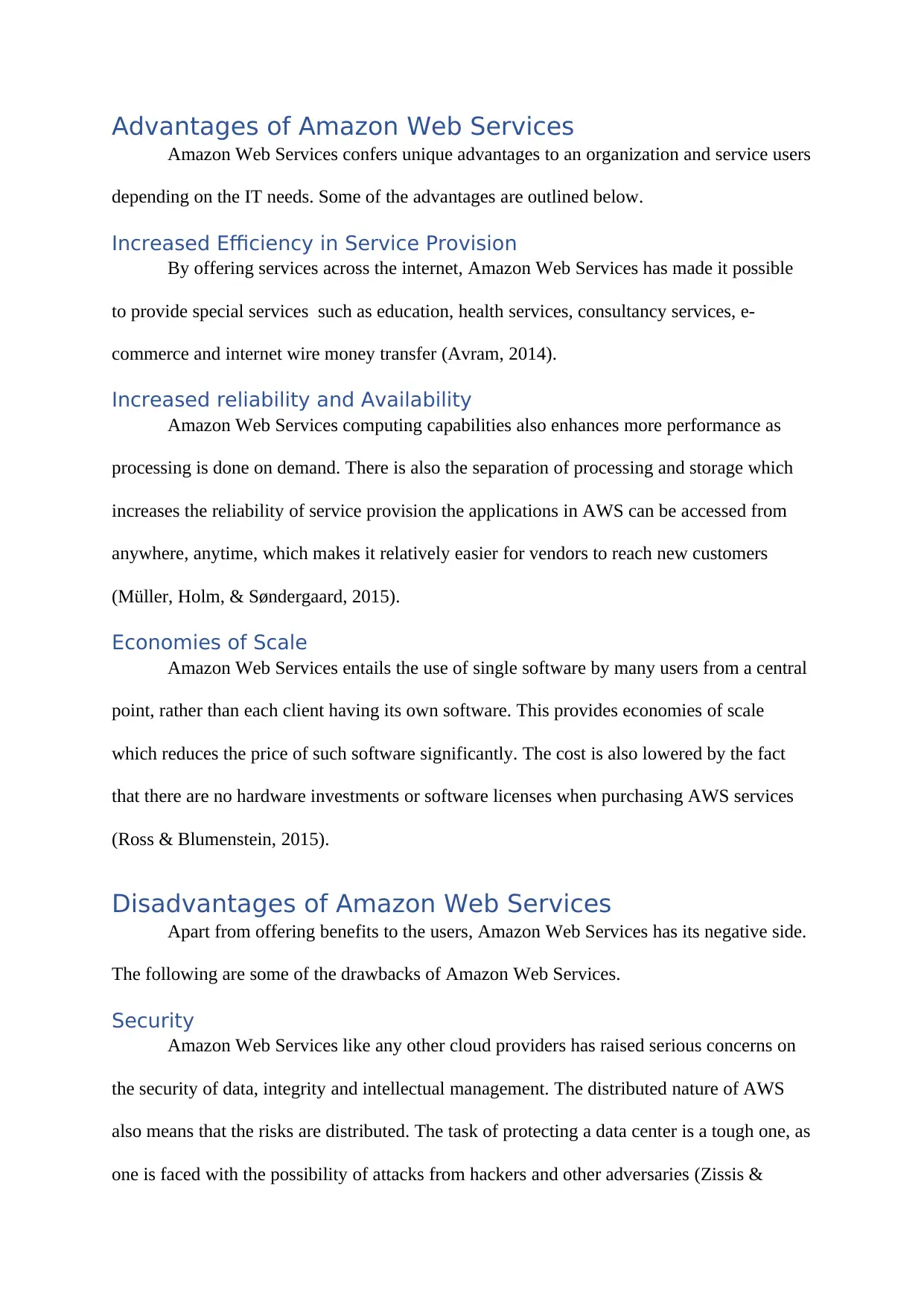
Advantages of Amazon Web Services
Amazon Web Services confers unique advantages to an organization and service users
depending on the IT needs. Some of the advantages are outlined below.
Increased Efficiency in Service Provision
By offering services across the internet, Amazon Web Services has made it possible
to provide special services such as education, health services, consultancy services, e-
commerce and internet wire money transfer (Avram, 2014).
Increased reliability and Availability
Amazon Web Services computing capabilities also enhances more performance as
processing is done on demand. There is also the separation of processing and storage which
increases the reliability of service provision the applications in AWS can be accessed from
anywhere, anytime, which makes it relatively easier for vendors to reach new customers
(Müller, Holm, & Søndergaard, 2015).
Economies of Scale
Amazon Web Services entails the use of single software by many users from a central
point, rather than each client having its own software. This provides economies of scale
which reduces the price of such software significantly. The cost is also lowered by the fact
that there are no hardware investments or software licenses when purchasing AWS services
(Ross & Blumenstein, 2015).
Disadvantages of Amazon Web Services
Apart from offering benefits to the users, Amazon Web Services has its negative side.
The following are some of the drawbacks of Amazon Web Services.
Security
Amazon Web Services like any other cloud providers has raised serious concerns on
the security of data, integrity and intellectual management. The distributed nature of AWS
also means that the risks are distributed. The task of protecting a data center is a tough one, as
one is faced with the possibility of attacks from hackers and other adversaries (Zissis &
Amazon Web Services confers unique advantages to an organization and service users
depending on the IT needs. Some of the advantages are outlined below.
Increased Efficiency in Service Provision
By offering services across the internet, Amazon Web Services has made it possible
to provide special services such as education, health services, consultancy services, e-
commerce and internet wire money transfer (Avram, 2014).
Increased reliability and Availability
Amazon Web Services computing capabilities also enhances more performance as
processing is done on demand. There is also the separation of processing and storage which
increases the reliability of service provision the applications in AWS can be accessed from
anywhere, anytime, which makes it relatively easier for vendors to reach new customers
(Müller, Holm, & Søndergaard, 2015).
Economies of Scale
Amazon Web Services entails the use of single software by many users from a central
point, rather than each client having its own software. This provides economies of scale
which reduces the price of such software significantly. The cost is also lowered by the fact
that there are no hardware investments or software licenses when purchasing AWS services
(Ross & Blumenstein, 2015).
Disadvantages of Amazon Web Services
Apart from offering benefits to the users, Amazon Web Services has its negative side.
The following are some of the drawbacks of Amazon Web Services.
Security
Amazon Web Services like any other cloud providers has raised serious concerns on
the security of data, integrity and intellectual management. The distributed nature of AWS
also means that the risks are distributed. The task of protecting a data center is a tough one, as
one is faced with the possibility of attacks from hackers and other adversaries (Zissis &
Paraphrase This Document
Need a fresh take? Get an instant paraphrase of this document with our AI Paraphraser
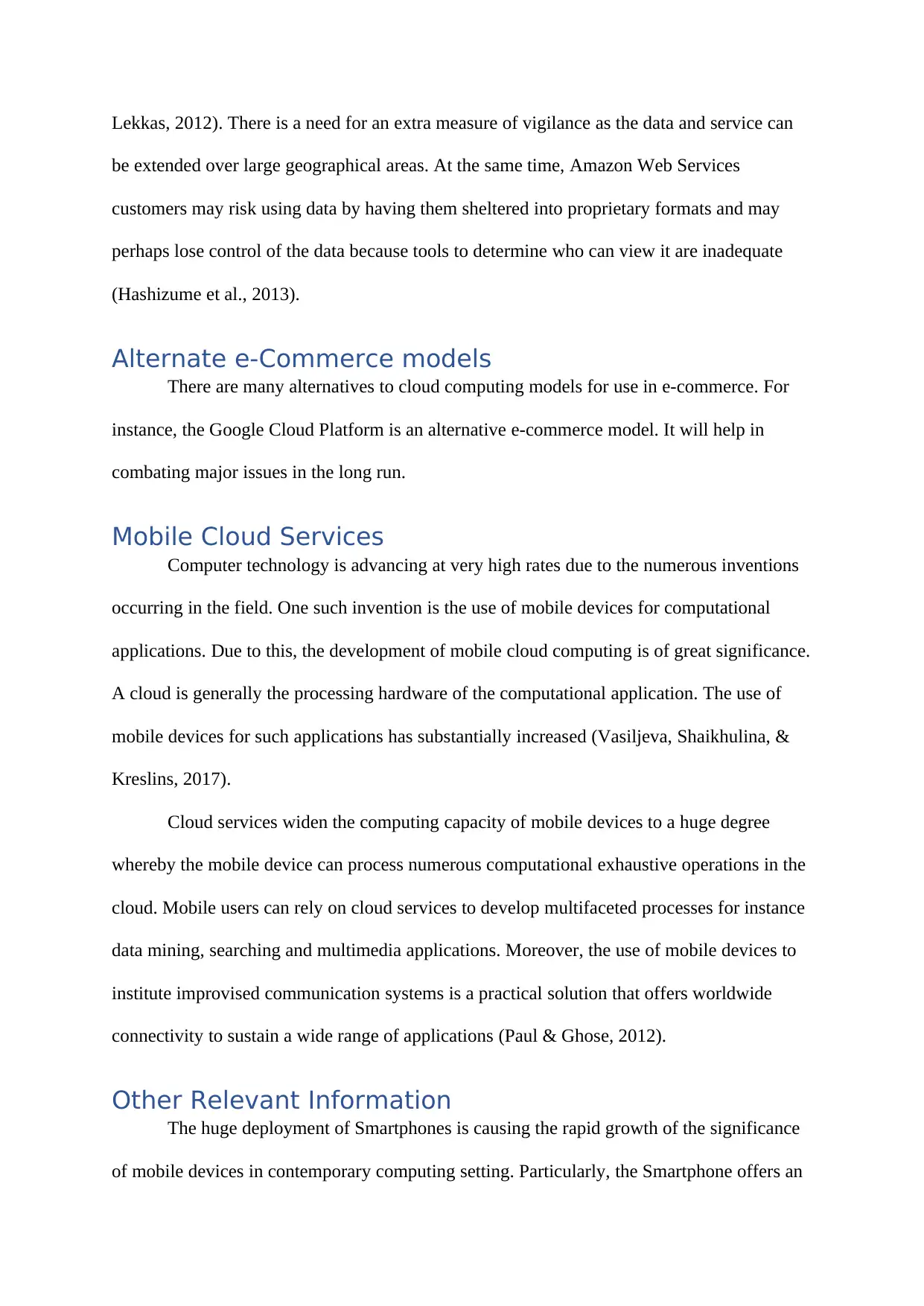
Lekkas, 2012). There is a need for an extra measure of vigilance as the data and service can
be extended over large geographical areas. At the same time, Amazon Web Services
customers may risk using data by having them sheltered into proprietary formats and may
perhaps lose control of the data because tools to determine who can view it are inadequate
(Hashizume et al., 2013).
Alternate e-Commerce models
There are many alternatives to cloud computing models for use in e-commerce. For
instance, the Google Cloud Platform is an alternative e-commerce model. It will help in
combating major issues in the long run.
Mobile Cloud Services
Computer technology is advancing at very high rates due to the numerous inventions
occurring in the field. One such invention is the use of mobile devices for computational
applications. Due to this, the development of mobile cloud computing is of great significance.
A cloud is generally the processing hardware of the computational application. The use of
mobile devices for such applications has substantially increased (Vasiljeva, Shaikhulina, &
Kreslins, 2017).
Cloud services widen the computing capacity of mobile devices to a huge degree
whereby the mobile device can process numerous computational exhaustive operations in the
cloud. Mobile users can rely on cloud services to develop multifaceted processes for instance
data mining, searching and multimedia applications. Moreover, the use of mobile devices to
institute improvised communication systems is a practical solution that offers worldwide
connectivity to sustain a wide range of applications (Paul & Ghose, 2012).
Other Relevant Information
The huge deployment of Smartphones is causing the rapid growth of the significance
of mobile devices in contemporary computing setting. Particularly, the Smartphone offers an
be extended over large geographical areas. At the same time, Amazon Web Services
customers may risk using data by having them sheltered into proprietary formats and may
perhaps lose control of the data because tools to determine who can view it are inadequate
(Hashizume et al., 2013).
Alternate e-Commerce models
There are many alternatives to cloud computing models for use in e-commerce. For
instance, the Google Cloud Platform is an alternative e-commerce model. It will help in
combating major issues in the long run.
Mobile Cloud Services
Computer technology is advancing at very high rates due to the numerous inventions
occurring in the field. One such invention is the use of mobile devices for computational
applications. Due to this, the development of mobile cloud computing is of great significance.
A cloud is generally the processing hardware of the computational application. The use of
mobile devices for such applications has substantially increased (Vasiljeva, Shaikhulina, &
Kreslins, 2017).
Cloud services widen the computing capacity of mobile devices to a huge degree
whereby the mobile device can process numerous computational exhaustive operations in the
cloud. Mobile users can rely on cloud services to develop multifaceted processes for instance
data mining, searching and multimedia applications. Moreover, the use of mobile devices to
institute improvised communication systems is a practical solution that offers worldwide
connectivity to sustain a wide range of applications (Paul & Ghose, 2012).
Other Relevant Information
The huge deployment of Smartphones is causing the rapid growth of the significance
of mobile devices in contemporary computing setting. Particularly, the Smartphone offers an
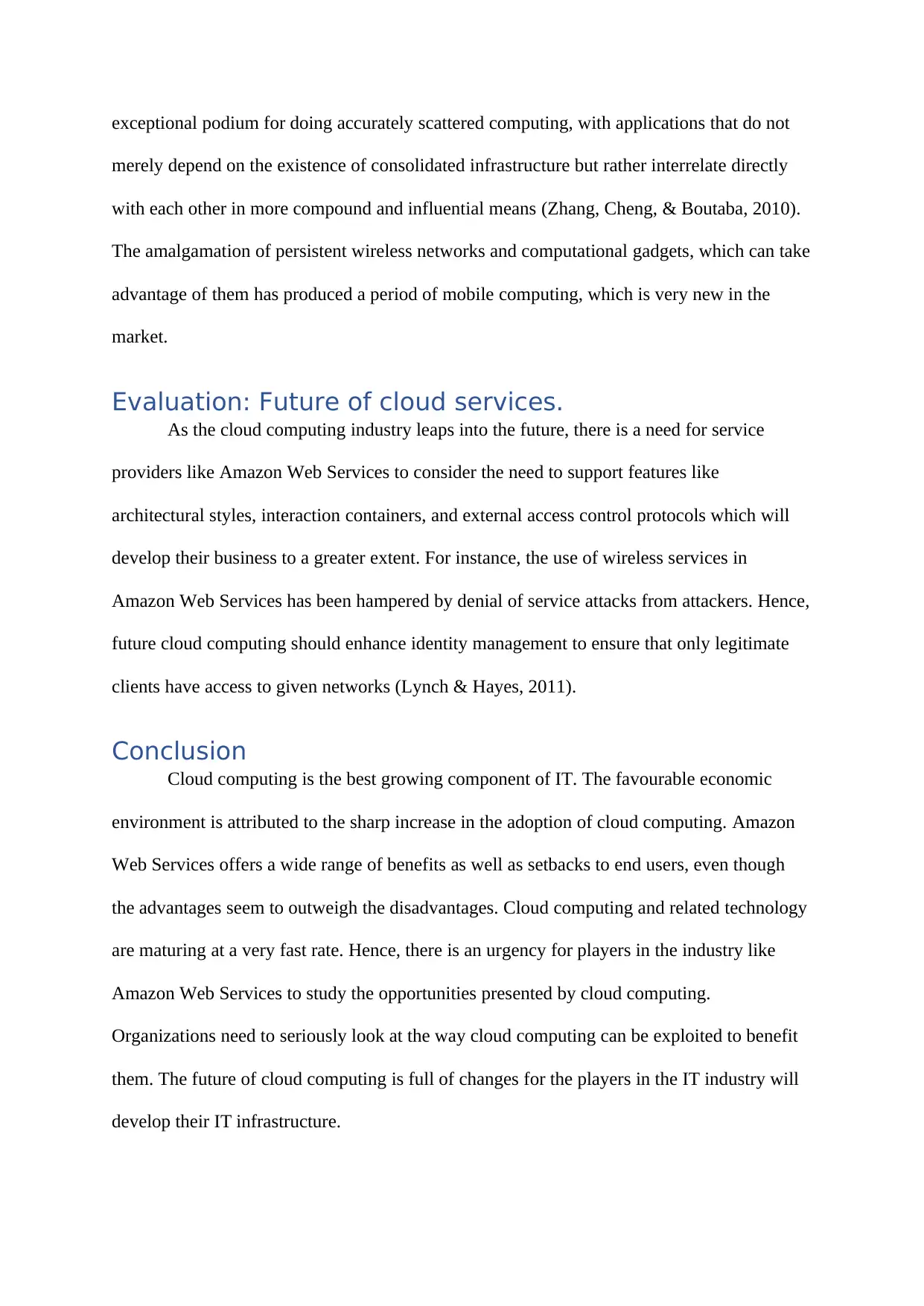
exceptional podium for doing accurately scattered computing, with applications that do not
merely depend on the existence of consolidated infrastructure but rather interrelate directly
with each other in more compound and influential means (Zhang, Cheng, & Boutaba, 2010).
The amalgamation of persistent wireless networks and computational gadgets, which can take
advantage of them has produced a period of mobile computing, which is very new in the
market.
Evaluation: Future of cloud services.
As the cloud computing industry leaps into the future, there is a need for service
providers like Amazon Web Services to consider the need to support features like
architectural styles, interaction containers, and external access control protocols which will
develop their business to a greater extent. For instance, the use of wireless services in
Amazon Web Services has been hampered by denial of service attacks from attackers. Hence,
future cloud computing should enhance identity management to ensure that only legitimate
clients have access to given networks (Lynch & Hayes, 2011).
Conclusion
Cloud computing is the best growing component of IT. The favourable economic
environment is attributed to the sharp increase in the adoption of cloud computing. Amazon
Web Services offers a wide range of benefits as well as setbacks to end users, even though
the advantages seem to outweigh the disadvantages. Cloud computing and related technology
are maturing at a very fast rate. Hence, there is an urgency for players in the industry like
Amazon Web Services to study the opportunities presented by cloud computing.
Organizations need to seriously look at the way cloud computing can be exploited to benefit
them. The future of cloud computing is full of changes for the players in the IT industry will
develop their IT infrastructure.
merely depend on the existence of consolidated infrastructure but rather interrelate directly
with each other in more compound and influential means (Zhang, Cheng, & Boutaba, 2010).
The amalgamation of persistent wireless networks and computational gadgets, which can take
advantage of them has produced a period of mobile computing, which is very new in the
market.
Evaluation: Future of cloud services.
As the cloud computing industry leaps into the future, there is a need for service
providers like Amazon Web Services to consider the need to support features like
architectural styles, interaction containers, and external access control protocols which will
develop their business to a greater extent. For instance, the use of wireless services in
Amazon Web Services has been hampered by denial of service attacks from attackers. Hence,
future cloud computing should enhance identity management to ensure that only legitimate
clients have access to given networks (Lynch & Hayes, 2011).
Conclusion
Cloud computing is the best growing component of IT. The favourable economic
environment is attributed to the sharp increase in the adoption of cloud computing. Amazon
Web Services offers a wide range of benefits as well as setbacks to end users, even though
the advantages seem to outweigh the disadvantages. Cloud computing and related technology
are maturing at a very fast rate. Hence, there is an urgency for players in the industry like
Amazon Web Services to study the opportunities presented by cloud computing.
Organizations need to seriously look at the way cloud computing can be exploited to benefit
them. The future of cloud computing is full of changes for the players in the IT industry will
develop their IT infrastructure.
⊘ This is a preview!⊘
Do you want full access?
Subscribe today to unlock all pages.

Trusted by 1+ million students worldwide
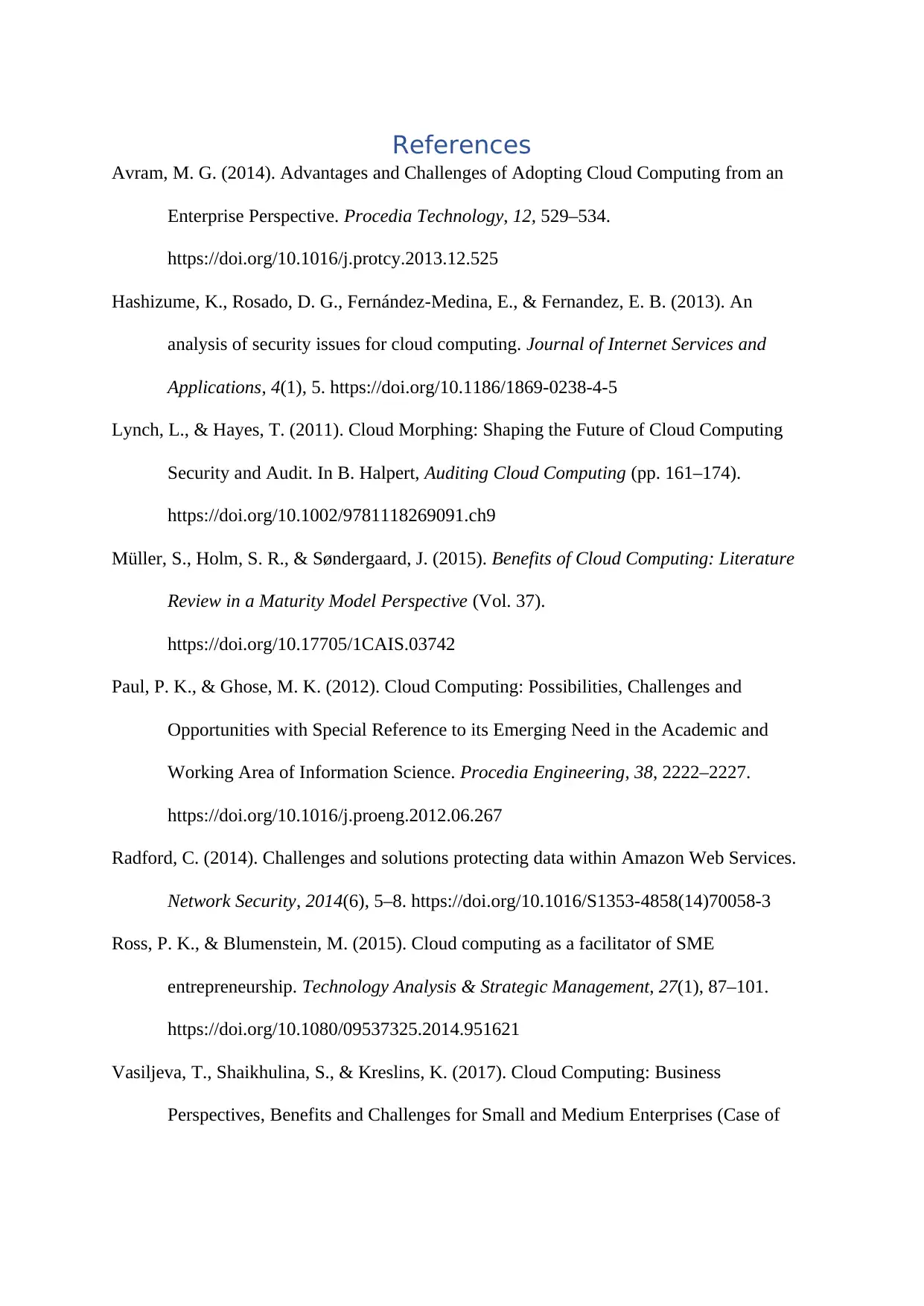
References
Avram, M. G. (2014). Advantages and Challenges of Adopting Cloud Computing from an
Enterprise Perspective. Procedia Technology, 12, 529–534.
https://doi.org/10.1016/j.protcy.2013.12.525
Hashizume, K., Rosado, D. G., Fernández-Medina, E., & Fernandez, E. B. (2013). An
analysis of security issues for cloud computing. Journal of Internet Services and
Applications, 4(1), 5. https://doi.org/10.1186/1869-0238-4-5
Lynch, L., & Hayes, T. (2011). Cloud Morphing: Shaping the Future of Cloud Computing
Security and Audit. In B. Halpert, Auditing Cloud Computing (pp. 161–174).
https://doi.org/10.1002/9781118269091.ch9
Müller, S., Holm, S. R., & Søndergaard, J. (2015). Benefits of Cloud Computing: Literature
Review in a Maturity Model Perspective (Vol. 37).
https://doi.org/10.17705/1CAIS.03742
Paul, P. K., & Ghose, M. K. (2012). Cloud Computing: Possibilities, Challenges and
Opportunities with Special Reference to its Emerging Need in the Academic and
Working Area of Information Science. Procedia Engineering, 38, 2222–2227.
https://doi.org/10.1016/j.proeng.2012.06.267
Radford, C. (2014). Challenges and solutions protecting data within Amazon Web Services.
Network Security, 2014(6), 5–8. https://doi.org/10.1016/S1353-4858(14)70058-3
Ross, P. K., & Blumenstein, M. (2015). Cloud computing as a facilitator of SME
entrepreneurship. Technology Analysis & Strategic Management, 27(1), 87–101.
https://doi.org/10.1080/09537325.2014.951621
Vasiljeva, T., Shaikhulina, S., & Kreslins, K. (2017). Cloud Computing: Business
Perspectives, Benefits and Challenges for Small and Medium Enterprises (Case of
Avram, M. G. (2014). Advantages and Challenges of Adopting Cloud Computing from an
Enterprise Perspective. Procedia Technology, 12, 529–534.
https://doi.org/10.1016/j.protcy.2013.12.525
Hashizume, K., Rosado, D. G., Fernández-Medina, E., & Fernandez, E. B. (2013). An
analysis of security issues for cloud computing. Journal of Internet Services and
Applications, 4(1), 5. https://doi.org/10.1186/1869-0238-4-5
Lynch, L., & Hayes, T. (2011). Cloud Morphing: Shaping the Future of Cloud Computing
Security and Audit. In B. Halpert, Auditing Cloud Computing (pp. 161–174).
https://doi.org/10.1002/9781118269091.ch9
Müller, S., Holm, S. R., & Søndergaard, J. (2015). Benefits of Cloud Computing: Literature
Review in a Maturity Model Perspective (Vol. 37).
https://doi.org/10.17705/1CAIS.03742
Paul, P. K., & Ghose, M. K. (2012). Cloud Computing: Possibilities, Challenges and
Opportunities with Special Reference to its Emerging Need in the Academic and
Working Area of Information Science. Procedia Engineering, 38, 2222–2227.
https://doi.org/10.1016/j.proeng.2012.06.267
Radford, C. (2014). Challenges and solutions protecting data within Amazon Web Services.
Network Security, 2014(6), 5–8. https://doi.org/10.1016/S1353-4858(14)70058-3
Ross, P. K., & Blumenstein, M. (2015). Cloud computing as a facilitator of SME
entrepreneurship. Technology Analysis & Strategic Management, 27(1), 87–101.
https://doi.org/10.1080/09537325.2014.951621
Vasiljeva, T., Shaikhulina, S., & Kreslins, K. (2017). Cloud Computing: Business
Perspectives, Benefits and Challenges for Small and Medium Enterprises (Case of
Paraphrase This Document
Need a fresh take? Get an instant paraphrase of this document with our AI Paraphraser

Latvia). Procedia Engineering, 178, 443–451.
https://doi.org/10.1016/j.proeng.2017.01.087
Zhang, Q., Cheng, L., & Boutaba, R. (2010). Cloud computing: state-of-the-art and research
challenges. Journal of Internet Services and Applications, 1(1), 7–18.
https://doi.org/10.1007/s13174-010-0007-6
Zissis, D., & Lekkas, D. (2012). Addressing cloud computing security issues. Future
Generation Computer Systems, 28(3), 583–592.
https://doi.org/10.1016/j.future.2010.12.006
https://doi.org/10.1016/j.proeng.2017.01.087
Zhang, Q., Cheng, L., & Boutaba, R. (2010). Cloud computing: state-of-the-art and research
challenges. Journal of Internet Services and Applications, 1(1), 7–18.
https://doi.org/10.1007/s13174-010-0007-6
Zissis, D., & Lekkas, D. (2012). Addressing cloud computing security issues. Future
Generation Computer Systems, 28(3), 583–592.
https://doi.org/10.1016/j.future.2010.12.006
1 out of 8
Related Documents
Your All-in-One AI-Powered Toolkit for Academic Success.
+13062052269
info@desklib.com
Available 24*7 on WhatsApp / Email
![[object Object]](/_next/static/media/star-bottom.7253800d.svg)
Unlock your academic potential
Copyright © 2020–2025 A2Z Services. All Rights Reserved. Developed and managed by ZUCOL.





